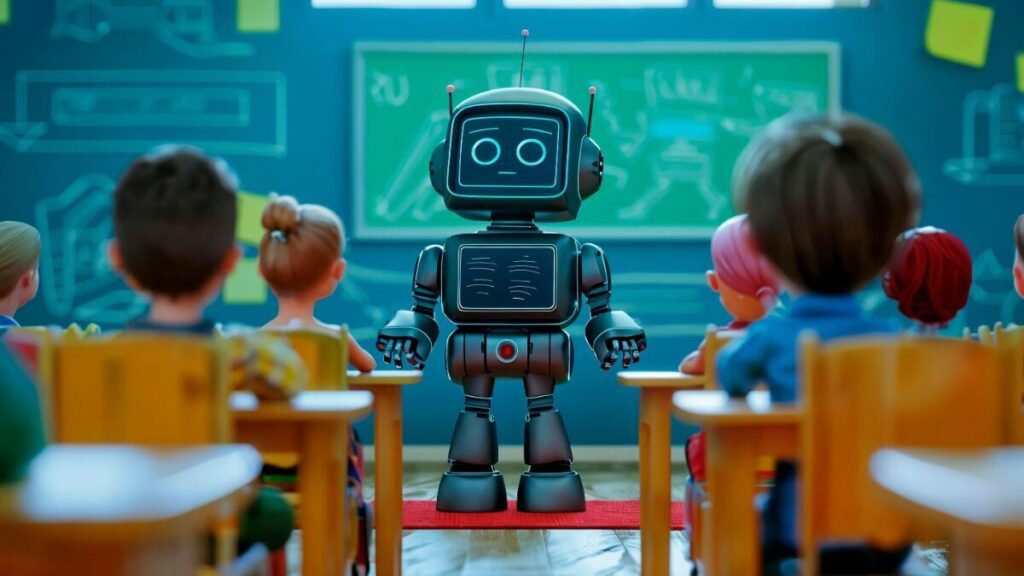Introduction
Imagine a classroom where each student has a personalized learning assistant, always on hand to support and guide them through lessons tailored to their unique pace and preferences. Artificial Intelligence (AI) is no longer a futuristic concept—it’s actively shaping today’s educational landscape. However, with all the talk about AI in education, the question remains: Is AI a game changer or another passing gimmick?
- Introduction
- What is AI in Education?
- Increasing Use of AI in Education Statistics
- How Does AI Affect Education Positively?
- How Does AI Affect Education Negatively?
- AI in Schools: Pros and Cons
- Why is AI Considered a Game Changer?
- Is AI Just a Gimmick?
- Real-Life Examples of AI in Education
- Step-by-Step Guide: Implementing AI in Schools
- Is AI Worth the Investment?
- Conclusion
This article explores the increasing use of AI in education, weighing its transformative potential and possible pitfalls. Using real-life examples and expert insights, we’ll examine how AI reshapes classrooms and whether it represents an enduring investment in better learning.
What is AI in Education?
Simply put, AI in education leverages algorithms and vast amounts of data to make intelligent, personalized decisions that support students and educators alike. For example, AI-powered educational tools can analyze how students learn, predict their needs, and adjust content to make learning more effective. From automated grading systems to advanced platforms that tailor entire learning experiences, AI transforms how students engage with the material.
Increasing Use of AI in Education Statistics
The adoption of Artificial Intelligence AI in education has been accelerating, with AI-based tools estimated to grow by 47.5% annually in the sector. These advancements are transforming everything from automated grading to fully personalized learning experiences. According to recent statistics, over 86% of educators believe that AI will be a crucial part of the future of education. With such rapid adoption, it is essential to examine how AI reshapes classrooms and whether it will bring lasting benefits or short-term novelty.
How Does AI Affect Education Positively?
Personalized Learning Paths
One of AI’s most powerful impacts is its ability to tailor lessons to individual learning styles. Rather than adhering to a one-size-fits-all approach, AI-based educational tools like DreamBox adapt to each student’s unique pace, providing a level of personalization that standard curriculums often can’t match. Adaptive learning platforms adjust content difficulty based on students progress, supporting those needing extra help and challenging those ready to advance.
Instant Feedback for Students and Teachers
One of the AI tools most praised features is its ability to provide real-time feedback. For example, Gradescope enables educators to grade assignments more efficiently, providing students with immediate insights. Instant feedback fosters a continuous improvement mindset, helping students quickly correct mistakes and develop new skills.
Improved Access to Learning Resources
AI-powered platforms like Khan Academy offer accessible, free resources that align with students’ learning needs. This round-the-clock availability of AI-driven learning aids has become an invaluable asset for students, especially those who may struggle to access traditional tutoring outside of school.
How Does AI Affect Education Negatively?
While AI in education offers transformative possibilities, it’s not without challenges. Here’s a look at some concerns:
Dependency on Technology
As classrooms increasingly adopt AI-based tools, there’s a risk of students becoming overly reliant on technology. This dependency could reduce critical thinking skills as students come to depend on AI for answers. Unlike human educators, AI cannot encourage empathy, creativity, or social skills integral to holistic learning.
Privacy and Data Security Concerns
AI requires vast data to operate effectively, often including sensitive information. The Family Educational Rights and Privacy Act (FERPA) provides guidelines for protecting student data, but concerns persist about the security of student information. Parents and schools must be vigilant about privacy when integrating AI applications into learning environments.
Unequal Access to AI Resource
AI has the potential to enhance learning, but access to AI-powered tools often depends on school budgets. Under-resourced schools may lack the technology needed to implement AI-driven learning platforms, which can exacerbate educational inequalities and leave some students without access to the same personalized resources.
AI in Schools: Pros and Cons
Pros of AI in Schools
- Personalized Learning: AI-based tools offer tailored learning experiences, catering to each student’s needs and helping them achieve their best.
- Efficiency in Grading and Feedback: Automated grading tools like Gradescope streamline the grading process, allowing teachers to focus on interactive, student-centered learning.
- Enhanced Access to Resources: Platforms such as Duolingo and Khan Academy provide supplemental resources that help students reinforce learning outside the classroom.
Cons of AI in Schools
- Privacy Risks: The data-driven nature of AI in education systems raises privacy concerns, especially as AI applications collect sensitive student data.
- Potential for Reduced Critical Thinking: Heavy reliance on AI in education may hinder students’ ability to think independently as they get used to having answers at their fingertips.
- Digital Divide: Schools with limited resources may struggle to integrate AI technology, increasing the digital divide in educational quality and access.
Why is AI Considered a Game Changer?
Personalized Learning Paths
Everyone learns differently, and AI-based educational tools recognize this. Rather than adhering to a one-size-fits-all curriculum, AI adapts lessons to each student’s unique pace. For instance, adaptive learning platforms like DreamBox use AI to adjust content difficulty based on each student’s performance. This is particularly useful in math classes where students often require specialized support. Personalized learning paths ensure that students can progress without being held back by the standard curriculum.
24/7 Availability
Imagine a student stuck on a challenging concept at 8 PM without anyone to turn to. With AI-powered tutoring systems such as ChatGPT, students have access to support around the clock. These virtual tutors can help students resolve their queries outside traditional school hours, offering flexibility that caters to today’s digital-first generation.
Instant Feedback for Teachers and Students
One challenge educators face is providing timely, constructive feedback. With AI-driven grading systems like Gradescope, teachers can assess student progress instantly, freeing time and ensuring no delay in feedback. Automated feedback systems help students immediately understand their mistakes, fostering a continuous improvement mindset.
Is AI Just a Gimmick?
AI has limitations even if it has a lot of promise. This begs the question: Is AI truly a revolutionary tool, or is it overhyped?
Dependency on Technology
Over-reliance on AI could lead to an unhealthy dependency. Students might come to rely on instant answers from AI tools, which could diminish critical thinking skills. In contrast, human teachers nurture creativity, empathy, and problem-solving—qualities that algorithms struggle to replicate. While AI can help teach factual subjects, can it inspire students to think creatively or fully grasp historical contexts?
Privacy Concerns
Implementing AI in education requires collecting significant amounts of data, often including sensitive student information. This can raise privacy concerns as schools and parents question how data is stored and who can access it. With the rise of AI applications in education, it’s vital to protect students’ data. Resources such as the Family Educational Rights and Privacy Act (FERPA) guidelines are essential for understanding the scope and limitations of data collection.
Equity Issues
While AI can potentially democratize learning, access to AI resources varies widely between schools. Wealthier institutions have the funds to invest in the latest AI tools, while under-resourced schools may struggle to keep up, leading to a digital divide. Some students may benefit from advanced, AI-driven learning platforms, while others are left out, exacerbating educational inequities.
Real-Life Examples of AI in Education
Duolingo: AI-Enhanced Language Learning
Duolingo, a popular language-learning app, uses AI to provide students with personalized language lessons. Duolingo’s AI algorithms assess students’ strengths and weaknesses in real-time, creating a customized learning path that adapts to each lesson.
DreamBox: Personalized Math Tutoring
DreamBox, an adaptive learning platform for K-8 students, uses AI to provide personalized math lessons. By identifying strengths and gaps, DreamBox helps teachers offer targeted support, which has proven especially beneficial for students who struggle with traditional approaches.
YouTube and Khan Academy: AI for Content Recommendations
Both YouTube and Khan Academy leverage AI algorithms to recommend videos tailored to students’ learning journeys. When responsibly managed, these recommendations provide students with supplemental resources that align with their academic goals.
Step-by-Step Guide: Implementing AI in Schools
Are you a teacher, administrator, or parent curious about incorporating AI tools in schools? Here’s a simple, step-by-step guide:
Identify Learning Gaps
Before implementing AI, assess which areas need the most support, such as personalized tutoring or instant feedback. This ensures that the integration of AI is strategic rather than simply adopting new tech for the sake of trend-following.
Explore Available AI Tools
Research and compare AI-powered educational tools to find those best suited to your school’s needs. While some tools are free, such as Khan Academy, others may require subscriptions. Selecting tools that meet learning objectives will ensure they provide value.
Pilot the Program
Consider starting with a pilot program introducing AI in a specific classroom or subject area. Gather feedback from students and teachers to refine the process before a full-scale rollout.
Train Staff and Students
Teachers and students need proper training to use AI in education technology effectively. Consider conducting workshops or training sessions to help everyone become comfortable with the new tools.
Monitor Impact and Adjust
After implementing AI in education, continuously assess its impact on learning outcomes. Adjust the technology’s usage as needed to ensure it’s contributing positively to the educational environment.
Is AI Worth the Investment?
So, is AI in education worth the investment, or is it a temporary trend? The answer may lie in how thoughtfully AI is applied.
While AI promises personalized learning and instant feedback, it’s not without challenges. AI In Education is a tool, not a replacement for teachers. By balancing AI with traditional teaching methods, we can use it to enhance rather than replace human-led education.
Conclusion
In conclusion, the increasing use of AI in education is likely here to stay, with its impact already evident in classrooms worldwide. While AI presents remarkable opportunities, it also requires careful integration to avoid potential pitfalls. By balancing AI-driven resources with human teaching, educators can create an innovative and supportive learning environment. Whether AI in education is a game changer or a passing gimmick depends on how thoughtfully we implement it. When used responsibly, AI technology promises a more accessible, customized, and effective education system for students everywhere.


